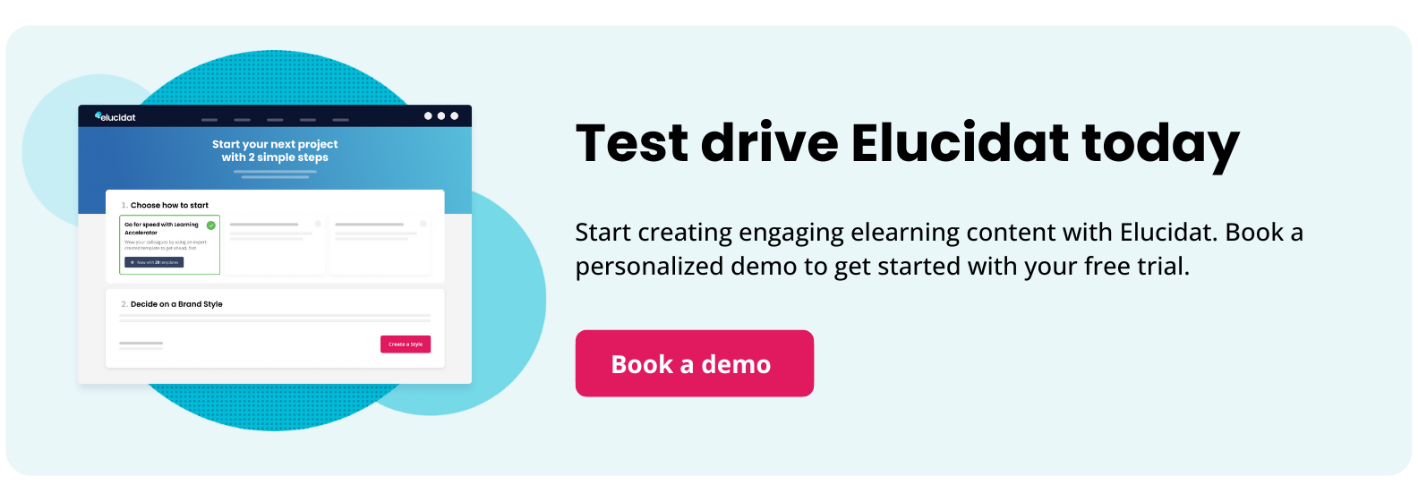How to make enterprise elearning a success
12 minute read
If you work for an enterprise organization, you will understand the pressures that come with this territory. You have a rapidly evolving business to keep up with, thousands of employees to train, and globally dispersed teams to involve. It’s no wonder many enterprise organizations are looking to streamline their L&D approach, often turning to elearning as the obvious solution. But what exactly is enterprise elearning? Why is it so suitable for these work environments? And how do you choose the right tools to make your elearning strategy successful? Read on to find out.

What is enterprise elearning?
Enterprise elearning is a broad term that might mean different things to different organizations. As a loose definition, it refers to using digital content, software, and cloud-based platforms to facilitate learning within a large corporation. This learning could be delivered to employees, third parties, customers, or any other type of stakeholder.
An enterprise elearning strategy typically involves creating online courses through an authoring tool and then organizing and delivering them through a Learning Management System (LMS).
Examples of enterprise elearning
You can create and host any kind of learning experience for your organization with elearning. But the types of elearning courses you might expect to see within enterprise organizations include things like:
- Compliance training: Elearning authoring tools can quickly create informative compliance courses, allowing you to keep up with the regulatory and legal landscape. These courses can be rolled out company-wide, providing employee certification in key areas such as health and safety, financial crime, and data protection. Check out this example of compliance training.
- Product knowledge training: Using enterprise learning tools, you can create engaging courses about your organization’s products and services to help your sales and marketing team understand their key features, thus enhancing the impact of your enterprise learning academy. An example of product knowledge training can be seen here.
- Sales training: In addition to product knowledge, sales employees and third-party distributors need the appropriate soft skills to promote these offerings and close deals. Elearning courses can help with this, using techniques like interactive scenarios so learners can practice navigating real customer conversations. You can see an example of sales training here.
- Process training: Enterprise organizations will likely be hot on SOPs and policies. Whether that’s how to manage a project, implement change, or conduct a risk assessment, these things are important to get right. Elearning can help break down these tasks into smaller parts and provide fun and engaging ways to reinforce key information. Plus, courses can be created and rolled out quickly, aligning with your evolving business needs. You can see an example of process training here.
Find more great examples of enterprise elearning courses here.
Why is enterprise elearning important?
For 96% of learning leaders, digital learning is rated as important or very important to their overall L&D strategy. But why is elearning so essential for enterprise organizations?
Firstly, think about the number of learners. You may have tens of thousands of employees spread across the globe who need to receive training in an accessible way. Your target learners might include customers and third parties (such as suppliers or distributors), increasing this number even more in the enterprise learning industry. You need cost-efficient and accessible methods of reaching these audiences.
Then, consider the diversity of training needs; Your organization will be split into many business areas requiring specialist knowledge and skillsets. With so many competencies to deliver against, you may need to develop and deliver many courses quickly.
Then think about how dispersed your experts are; You may have SMEs across different locations, business areas, and time zones, whose knowledge needs to come together to produce the most informative and relevant content. You need a central location – a single point of truth – through which SMEs and L&D experts can develop content together.
Then look at things from a learner’s point of view; Within a large organization like yours, employees are likely to feel overwhelmed with training for things like onboarding, processes, systems and software, and compliance. They may have monthly training assignments to tackle – and firm deadlines in which to do it. They need courses that will inspire rather than drain them whilst giving them the information they need.
You can learn more about corporations’ training needs in this article.
6 benefits of enterprise elearning
You’ve explored enterprise companies’ L&D needs. Now, let’s focus on how enterprise elearning can meet these needs. Here are just some of the benefits of implementing an elearning strategy.
- Improve business performance
Enterprise elearning makes it quick and easy to develop and roll out training. Most authoring tools have a user-friendly interface and offer pre-configured templates to help speed up your course production. This means you can respond to your organization’s ever-changing needs and close skills gaps promptly, allowing you to stay ahead in a competitive market.
Furthermore, learning online makes it easy to deliver and track online assessments, so you can be sure your learners have acquired the skills they need to tackle your latest business challenges.
- Engage employees
Enterprise elearning solutions put the power in your learners’ hands. They provide them with relevant training content that can be accessed from any device and location at their own pace. This helps ensure all your employees are fulfilling their roles to the best of their potential and have the opportunity to further their careers. Which in turn will boost engagement across your organization.
And of course, with the right tools, your content creators can develop learning experiences that aren’t just informative but motivating, using things like personalized learning and gamification. So, instead of feeling entrapped by long-winded classroom training or archaic ‘click-next-to-continue’ courses, your learners will have an interactive approach to learning and development.
- Reduce turn over
82% of employees who have access to relevant training at the point of need and who feel engaged and inspired by these materials are more likely to stay in your organization.
Closing skills gaps and ensuring employee competency will also make life easier for managers, who will feel a greater sense of job satisfaction and loyalty to your brand.
Happy employees and happy managers mean reduced staff turnover.
- Reach global audiences
Elearning platforms enable you to host content in one location and reach employees worldwide. All your learners need is an internet connection.
Moreover, most platforms can be accessed in different languages, making them a great choice for global enterprises. Many will also provide features to support elearning translations so you can tailor your courses to learners worldwide.
- Meet compliance requirements
Elearning transforms compliance training, making it both accessible and engaging. However, creating courses is only one aspect. Hosting and tracking these courses on an enterprise elearning platform ensures all employees complete this essential training.
This approach helps you tick all the boxes to meet regulatory requirements.
- Pool resources and expertise
Elearning within enterprise settings offers substantial benefits by pooling resources and expertise across the organization. Using software, like elearning authoring tools and LMSs allows for the collaborative creation and sharing of knowledge, leveraging employees’ collective skills and experiences.
By harnessing the diversity of expertise available within the organisation, elearning facilitates the development of comprehensive training materials that cover a wide range of topics and perspectives. This enhances the learning experience and promotes a culture of continuous learning and development.
How to implement enterprise elearning
So, you’ve decided you want to implement enterprise elearning. What are the key considerations and decisions that need to be made?
Decide on your needs
Before you pick your tools, you should consider your business needs.
Firstly, think about your users (that’s your learners, your content creators, and your content administrators):
- What languages do you need to support?
- Are your target learners all employees, or will they include suppliers, distributors, and/or customers as well? Do you need to target these groups separately?
- How many learners, content creators, and administrators do you need to support?
- What are your content creators’ and administrators’ capabilities? Will they need tools that are easy to set up and configure? Will they need advanced technical support?
Think about what content you have or need to create:
- Will you be creating bespoke training or using out-of-the-box courses?
- Does your content lend itself to particular formats (systems training, videos, or microlearning)?
- Do you have virtual classroom sessions or other types of training content, such as PDF guides, videos, PowerPoint decks, etc., that you’d like to host alongside your elearning courses?
- How much content do you need to create and/or host?
- What data and insights will you want to obtain regarding these learning experiences?
Then consider technological factors:
- Does your organization use other software and tools that must be integrated with your online learning platform/s?
- Will your content creators have a decent internet connection and bandwidth to access the elearning provider’s resources without interruptions?
- How do your learners usually access content? Will they just be using PCs, or might they want to use mobile devices?
Pick an LMS
Then, you need to choose an LMS. Administrators use these platforms to house and manage their content, deliver it to learners, and obtain data about course completions and reach.
In looking for an enterprise LMS, keep an eye out for these capabilities:
- Enabling fast and easy content updates to reflect the changing nature of your business and training needs.
- Delivering a solid mobile learning experience so learners can access content on the go and at the point of need (some may provide a separate mobile app).
- Integrating seamlessly with other applications enables you to house and track content from other platforms and use applications to schedule events, access databases, join video conferences, and more.
- Enables you to pull this content and experience into learning pathways that can be assigned to learners.
- Tracking content completion and providing detailed reports about who is accessing and completing what, as well as learner certification.
- Making content delivery fun. (Many LMSs now use gamification elements, such as leaderboards, points, and badges, to drive learner engagement.)
- Using cloud services with unlimited storage space to host your content.
- Being highly customizable, so you can accurately reflect your organization’s brand.
- Being available in different languages to support globally dispersed learners and administrators.
- Offering advanced features to support social learning and user-generated content.
In deciding whether an LMS is right for your organization, consider requesting a product demo, exploring case studies on the company’s website, and reading third-party reviews.
This article about alternative to LMS can help you understand more about elearning plaforms.
Pick an authoring tool
As an enterprise organization, you might have existing content (PDFs, videos, PowerPoint decks, and virtual training sessions) that you want to host via your LMS. However, your learning strategy will mostly consist of online courses, which means you’ll need an authoring tool to create them.
In picking an authoring tool for an enterprise organization, look out for a product with the following capabilities:
- Providing a vast scope for customization, so you can design your layouts, colours, fonts, etc, to match your brand.
- Offering a rich authoring toolkit and the ability to create elearning experiences, such as games and personalized learning.
- Providing options to simplify the authoring experience for your novice content creators.
- Offering features dedicated to speeding up content development.
- Facilitating a streamlined approach to content reviews and collaboration, preferably using cloud storage.
- Allowing authors to share templates and assets easily.
- Offering payment plans that reflect economies of scale.
To decide whether an authoring tool is right for you, inquire about a free trial, see a product demo, and look for case studies of success stories.
Top three enterprise elearning authoring tools
We have given you a head start in picking your authoring tool by reviewing the three top products below.
Elucidat
Elucidat is designed with enterprise organizations in mind. Here’s why…
For a start, Elucidat makes content creation a breeze so you can match the pace of your evolving business needs. It offers a what-you-see-is-what-you-get interface, automatic mobile optimization, and ready-made templates so your authors can create courses as quickly and easily as necessary.

Unlike many other authoring tools, with Elucidat, speed and usability are not at the expense of content quality. It supports a wide range of learning experiences, such as personalized learning, gamification, and social learning, so your authors can create highly engaging, people-centred content to retain your learners’ interest.
What’s more, Elucidat makes collaboration between team members seamless; cloud-based authoring means authors, graphic artists, and SMEs can work on the same course simultaneously, and all their contributions can be published instantly to a live version. You can even use Advanced User Management to control what each type of user does, ensuring everyone works to their strengths.
It’s easy to ensure consistency when your teams are working at scale; your authors can set up your Brand Style and make it available for reuse across projects. What’s more, with Guided Authoring, your design experts can share pre-approved company templates packed with inline guidance with your authors, helping you open up production across your organization.
Finally, Elucidat is great for global businesses. The interface is available in multiple languages, and the Auto-Translate feature instantly translates course content into one of 75 different languages, making it one of the most competitive authoring tools for course translations.

Articulate 360 (Storyline 360 and Rise 360)
Storyline 360 is a desktop tool with a PowerPoint-style slide-based approach to learning development. Pretty much any type of interaction can be created in Storyline 360, meaning content can be as bespoke and people-centred as required—it’s just about taking the time to learn the ropes. However, because Storyline is a desktop tool, collaboration can be very difficult. Authors will have to work locally and upload their courses for review, and there’s no easy way of sharing assets or branding between teams.

If you want to work faster and more collaboratively, Rise 360 is a better option. It provides a more simplistic, cloud-based approach to authoring. Plus, courses are saved centrally to be shared and edited amongst team members easily. However, there’s not much you can do with Rise 360 beyond the set interactions, which means the main drawback of using Rise 360 to create courses at scale is that the learning experiences may start to feel quite repetitive to your audiences. The interface is also only available in English, making it unsuitable for global teams.
Overall, the Articulate 360 package may be good for enterprises who want to switch between Storyline 360 and Rise 360, but if you need one tool to cover all bases, you’ll want to look elsewhere.
For a full review, you can check out our Elucidat vs Articulate review.
iSpring
iSpring Suite is a desktop authoring tool built into PowerPoint. It serves the general needs of enterprises well, mostly because it’s designed to simplify course creation. It offers straightforward video and audio creation functions, a PowerPoint converter, and an AI assistant, all of which help speed up authoring.

However, creating people-centred learning experiences with iSpring can be more challenging, as there aren’t many interactions available, and the customization options are limited. Moreover, being a desktop tool means you can’t instantly publish courses or share templates or content between authors, so it may not be the best choice for working at scale.
We have reviewed Elucidat vs iSpring Suite in this article.
For a wider snapshot of the best authoring tools on the market, have a look at our latest review.
Why choose Elucidat for your enterprise elearning needs?
Elucidat is designed specifically for enterprise organizations. It is easy to use, so you can onboard new authors quickly, meet your ever-changing business needs, and create high-quality, people-centred courses.
Even better, Elucidat makes it easy for teams to collaborate and work at scale. Your authors can share elearning templates, instantly publish courses for review, and roll out global content updates while your administrators have the controls to keep everything in check.
So, when it comes to enterprise elearning, while other authoring tools may just tick a few boxes, Elucidat fully passes the test.
Find out more about Elucidat for enterprises by booking a demo or starting a free trial today.



